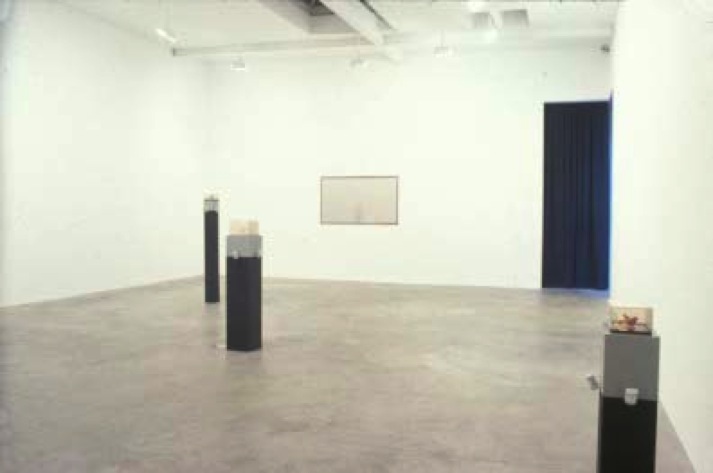Painting, the movie
2000, Postmasters Gallery, NYC
Painting, the movie
2000, Postmasters Gallery, NYC
I will describe this performance/installation as it was experienced by the spectator: As you enter the room of the gallery or museum you see that there are three small transparent boxes suspended on simple shelves from the ceiling and one large framed minimalist painting on the far wall. As you approach the boxes you can see that there is an object inside: a woman’s ankle, an ear, for example. But, when you get within a certain distance of the sculptures the transparent glass of the boxes becomes opaque making it impossible to scrutinize the object closely. When you step away from the boxes the glass switches back to transparent. The painting works in reverse of the sculptures. You can see there is a whitish opaque surface with very subtle thin lines running across it but as you get even closer to the painting, without warning, it changes from a two-dimensional, opaque surface to a transparent window through which you can see a three-dimensional live installation. When you step away from the “painting” the surface will return to its original opaque state.
The technology used is LCD glass, video cameras and monitors, and a motion, light or sound detector that is used as a switching mechanism for the LCD glass. For the duration of the installation a scene was depicted within the “painting”. The scene was based on an interior shot from the film Throne of Blood (Kurosawa). In this interior the main female character of the film was be placed, performed by me. I used this cinematic moment and character in order to create the environment of the installation and the movements I was making within them. I did not try to re-create exactly a scene from this film but rather borrowed aesthetic and emotional information from it. I, of course, was installed in the piece for all hours that the exhibition was open to the public. This work explores issues of visibility and invisibility by referencing cinema, light, dimension, and live body verses projected image. Painting, the movie also confronts the matter of appropriate context by magnifying the transitory properties of “static” visual art and “active” live art.


